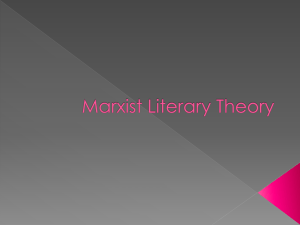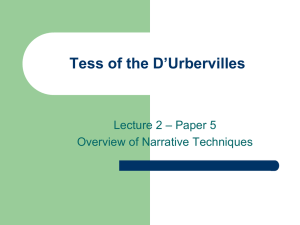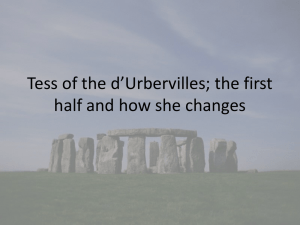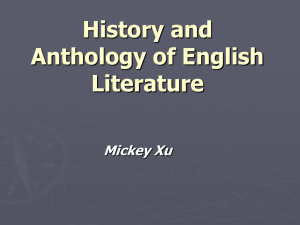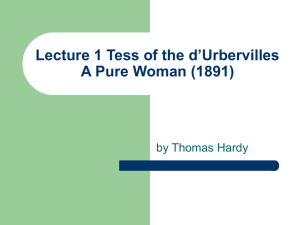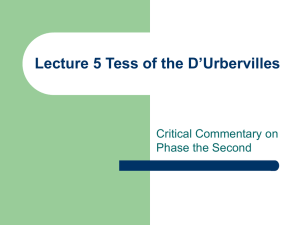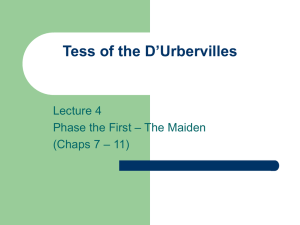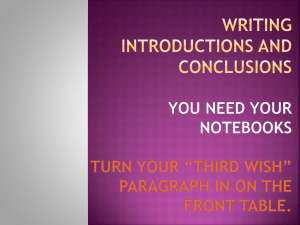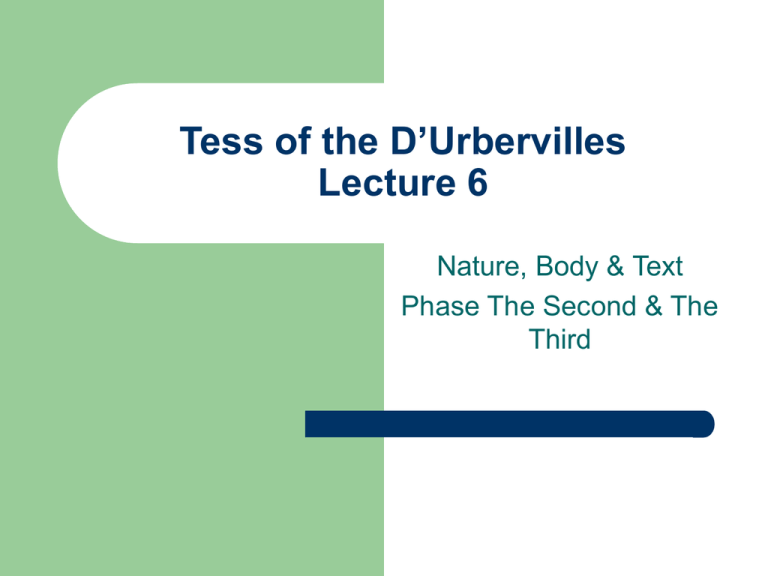
Tess of the D’Urbervilles
Lecture 6
Nature, Body & Text
Phase The Second & The
Third
Nature
Hardy’s use of pastoral settings expresses his
sense of opposition btwn nature & society /
culture
Opposition btwn the spontaneity of nature and
the legal rigidities of social institutions &
conventions
Hardy evokes Nature not only as a physical presence /
landscape, but also as a principle to defend Tess’s purity.
“Most of her misery had been generated by her
conventional aspect, and not by her innate sensations.”
(Ch.14, p.91)
Tess as a natural “creature” that should not be
condemned by society’s “arbitrary law”
“Was once lost always lost really true of chastity? …The
recuperative power which pervaded organic nature was
surely not denied to maidenhood alone.” (Ch.15, p.99)
Competing visions of Nature through an
interplay of multiple perspectives
The ‘naturalness’ of sexuality can be used to
challenge repressive social conventions…
but the ‘natural’ is also indifferent, which is
wrested into meaning in conflicting ways.
• “On these lonely hills and dales her quiescent glide was
a piece with the element she moved in. Her flexuous and
stealthy figure became an integral part of the scene. At
times her whimsical fancy would intensify natural
processes around her till they seemed a part of her story.
Rather, they became part of it; for the world is only a
psychological phenomenon, and what they seemed they
were.” (Chap 13, p.85)
• Tess as an isolated individual even as she is assimilated
into the landscape
Conflict btwn the way Hardy’s characters
experience themselves as living subjects, and the
way they appear in the objectifying gaze of others
Tess’s awareness of her own pulsating life
overshadowed by a sense of her “blank” externality
for others
We can get Nature wrong, just as the ‘naturalness’
of Tess can be misread.
Nature in Male/Female Relations:
Angel Clare & Tess
“What a genuine daughter of Nature that milkmaid is!”
(Clare in Ch.18, p.120)
Angel Clare idealises Tess as a pure child of Nature, a
projection of his Romantic vision of pastoral innocence.
Irony is that it is Tess’s felt alienation from Nature
through her musings which draws Angel to her in the
first place (e.g. “one lost in meditation”)
Angel shown to be self-deceiving in his spiritualisation
of Tess’s ‘nature’:
“She was no longer the milkmaid, but a visionary
essence of woman – a whole sex condensed into one
typical form.” (Ch.20, p.130)
Angel names Tess Artemis and Demeter, which Tess
herself repudiates: “Call me Tess” (p.130) – the use of
cultural allusions exposes Angel to be more
conventional than he thinks he is.
Nature – Setting, Imagery & Characterisation
Nature as setting that is both symbolic &
realistic
Natural scenes of brimming fertility & growth
at Talbothays mirror the burgeoning love of
Tess & Angel.
Description is poetic and sensuous, which
situates human desire in relation to the wider
natural world.
“Amid the oozing fatness and warm ferments of the Var
Vale, at a season when the rush of juices could almost be
heard below the hiss of fertilization, it was impossible that
the most fanciful love should not grow passionate. The
ready bosoms existing there were impregnated by their
surroundings.” (Ch.24, p.149)
“And as Clare was oppressed by the outward heats, so was
he burdened inwardly by a waxing fervour of passion for
the soft and silent Tess.” (p.149)
Natural settings, with the evocation of growing
summer heat and milking as a courtship ritual, serve
as a sublimation of the sexual attraction btwn Angel
& Tess.
“It is the repression of the sexual nature of the
attraction btwn Angel & Tess that makes the natural
imagery so powerfully metaphorical.” - Marjorie
Garson, 1991
Contrast btwn the Talbothays in the Valley of the great
Dairies (esp. Ch.24) and the overgrown “rank” garden
through which Tess moves towards the sound of Angel’s
harp (Ch.19)
The “rank” garden in Ch.19 as an image of unconstrained,
“uncultivated” nature:
“tall blooming weeds emitting offensive smells – weeds
whose red and yellow and purple hues formed a polychrome
as dazzling as that of cultivated flowers” (p.122)
Wild, exuberant, anarchic life that flourishes on the dark
underside of the cultivated fertility of the valley.
Tess moves through this sensuous and even
threatening garden apparently oblivious to it, “conscious
of neither time nor space” (p.123)
Animal imagery associates Tess with this wild fecundity
of nature – “she went stealthily as a cat”; “a fascinated
bird” (p.122)
Sense of Tess as a ‘child of Nature’ extends far beneath
the surface of conventional pastoral prettiness and
innocence which that phrase denotes to Angel
Recap: On Nature
The natural world in itself has no moral significance
(i.e. amoral & indifferent).
Natural forces and human life converge in the human
sexual impulse, which is thus essentially amoral
It is characters who invest and impose conflicting
meanings onto the naturalness of the sexual impulse
that partly drives the tragedy.
Nature pervades setting & imagery in Hardy’s
presentation of relationships in Tess
Male/Female Relations: Natural Imagery
Network of natural images built to structure
parallels and contrasts btwn the Angel/Tess
romance with the Alec/Tess violation:
Sun
Mist/Fog and Tear
Water
Animals
The Sun
Hardy elevates the sun-figure in Tess to the
significant status of a Pagan God.
Significance of the sun in the May-dance
festivity at the beginning of the novel:
“Ideal and real clashed slightly as the sun lit up
their figures” (Ch.2, p.13)
Symbolic of generative energy for procreation,
growth & warmth
Significant that the courting scenes btwn Angel & Tess in
Phase the Third take place mainly before sunrise
Echoes the pre-creation setting, with Angel & Tess
likened to Adam & Eve (i.e. Christian allusion)
“they seemed to themselves the first persons up of all the
world… The spectral, half-compounded, aqueous light
which pervaded the open mead, impressed them with a
feeling of isolation as if they were Adam and Eve.”
(Ch.20, p.130)
Parallels the seduction / rape at The Chase which takes
place in the early hours of Sunday: “Already at that hour
some sons of the forest were stirring and striking lights in
not very distant cottages” (Ch.11, p.74)
However, unlike Angel who spiritualizes the “ethereal
beauty” of Tess in that “preternatural time” of “spectral,
half-compounded, aqueous light”, Alec eroticizes her
“pale nebulousness” in the “blackness” at The Chase.
Complicates Tess as Eve – spiritualized mate and/or
fallen woman?
Pagan vs. Christian attitude towards the sun
Complicates the characterization of Tess as a pagan at
heart, though a Christian in life
“women whose chief companions are the forms and
forces of outdoor Nature retain in their souls far more of
the Pagan fantasy of their remote forefathers than of
the systematized religion taught to their race at later
date” (Ch.16, p.104)
Warm touch of the sun on the lovers, especially Tess
“You are like an undulating billow warmed by the sun”
(Ch.23, p.145) – emphasizes Tess’s sensuousness &
sensuality
In contrast, Angel’s love is said to be lacking in sexual
warmth: “He saw her grow warm” (Ch.23, p.145); “the sun
slanting in by the window upon his back” vs. Tess who is
“warm as a sunned cat” (Phase the Fourth, Ch.27, p.169)
Though lacking in sexual warmth, Angel’s love is cultured
and restrained, unlike Alec’s.
Irony – the sun seems to have chosen Tess as a victim
On her marriage evening, the sun casts an ominous
spotlight on Tess – it “formed a golden staff which
stretched across to her skirt, where it made a spot like a
paint-mark set upon her” (Phase the Fourth - Ch.34,
p.217)
Echoes an earlier simile of the evening sun as being
“like a great inflamed wound in the sky” (Ch.21, p.136)
Tess sacrificed to the Sun at the altar of Stonehenge at the
novel’s ending
“And you used to say at Talbothays that I was a heathen. So
now I am at home.” (Phase the Seventh, Ch.58 – p.393)
Extends an earlier reference to rituals of sun worship – “the
old-time heliolatries” (Ch.14, p.86)
Separation of the lovers fulfills an even earlier description of
how “the rays of the sun had absorbed the young stranger’s
retreating figure” (Ch.3, p.19)
Tess as a victim of her paganism as of her Christian training
Mist / Fog and Tears
Misty surroundings associated with obscurity,
veiled consciousness, sexual longing & amatory
anticipation
The “mists of pollen” at the garden where Tess
moves towards the music from Angel’s harp
(Ch.19) echoes the clouds of dust in the barn at
Chaseborough (Ch.10), as well as the foggy
night of the rape/seduction scene at the Chase
(Ch.11)
Angel Clare embraces Tess in Ch.24 in the middle of
the day at the height of summer.
Contrast to the midnight scene in The Chase.
Tess’s tears upon being embraced by Angel echoes
scene in the Chase where “beginning with one slow
tear, and then following with another, she wept
outright” (p.72)
Water
Angel-Tess
“All the while they were
converging, under an
irresistible law, as surely
as two streams in one
vale.” (Ch.20, p.129)
“an undulating billow
warmed by the sun. And
all this fluff of muslin
about you is the froth”
(Ch.23, p.145)
Alec-Tess
“He touched her with his
fingers, which sank into
her into a billow. ‘You
have only that puffy
muslin dress on – how’s
that?’” (Ch.11,p.72)
Animals
Angel-Tess
“She went stealthily as a
cat” (Ch.19,p.122)
“Having been lying down
in her clothes she was
warm as a sunned cat”
(Ch.27,p.169)
“fascinated bird”
(Ch.19,p.122)
Tess as emotional &
sensuous, neither so
intellectual as Angel nor
so ‘perverted’ as Alec
Alec-Tess
Emphasis on Tess as the
hunted, a wildness that
warrants male taming &
domestication
Caged birds
“the hopping rabbits and
hares”; “A little rest for the
jaded animal” (Ch.11)
Queer temper of Tib, the
mare (Ch.8)
Woman as Object of the Male Gaze
Hardy has created a narrator who oscillates btwn the
extremes represented by Angel & Alec
Misreading of the naturalness of Tess’s sexuality
through the societal lenses of class & religion
Angel & Alec as opposites in their attitudes towards
love
But it is both Angel’s excessive spirituality and Alec’s
excessive sensuality that destroy Tess the heroine
Both men presented as insensitive to an inner
Tess, the ‘Tess’ as she experiences herself, to
which we as readers seem to be given a
privileged insight.
Less an illegitimate pregnancy which destroys
a woman than the self-righteousness of an
attenuated and misapplied Christianity?
However, Angel could be said to be a much
more fully developed figure, and a more
believable one.
Is Hardy, even as he is critical of Angel’s
treatment of Tess, using Angel as a device to
spiritualise the femininity of Tess on his own
behalf?
Body
Hardy assimilates Tess’s speech to her body
“her mobile peony mouth and large innocent eyes
added eloquence to colour and shape” (Ch.2, p.14)
Body language encoded as feminine
Of a woman’s speaking “parts”, the heart is one of
the most impt:
When Tess baptizes her dying child Sorrow, she
speaks “boldly and triumphantly in the stoptdiapason note which her voice acquired when her
heart was in her speech” (Ch.14,p.95)
Essential to Hardy’s presentation of Tess as a young
woman who yearns to leave her body behind while
stargazing is the treachery of a woman’s body as
voice.
“by fixing your mind upon it [some big bright star],
you will soon find that you are hundreds and
hundreds o’ miles away from your body, which you
don’t seem to want at all” (Ch.18, p.120)
Body / Soul split in the char. of Tess
Significance of the motif of the dream / reverie / sleep
Angel’s sin against Tess is his failure to recognize that Alec
has possessed Tess’s body but not her soul.
The narrator emphasizes Tess’s growing dissociation from
her own body.
By the end of the novel, Angel Clare is forced to
acknowledge that “his original Tess had spiritually ceased
to recognize the body before him as hers – allowing it to
drift, like a corpse upon the current, in a direction
dissociated from its living will”.
Body/Soul split is marked in Hardy’s women characters
partly because patriarchal ideology insists that they be
seen and objectified.
The novel takes Tess from being a she, to a collection
of aspects, to an it, and ultimately to a nothingness, as
if to free her from constructions put on her by society
and individuals.
Tess’s body virtually disappears altogether at the
execution, marked only as having once existed by the
raising of the black flag.
Distillation of the spirit of Tess’s purity
Is this yet another idealization of women as all spirit
by a male author Hardy himself?
Or, in ultimately removing Tess, is Hardy ironically
mocking the idealizing aspects of Angel in himself?
Writing may lodge Tess, but cannot contain her for
she and her powers are greater than the narrator’s
or the novelist’s hold.


